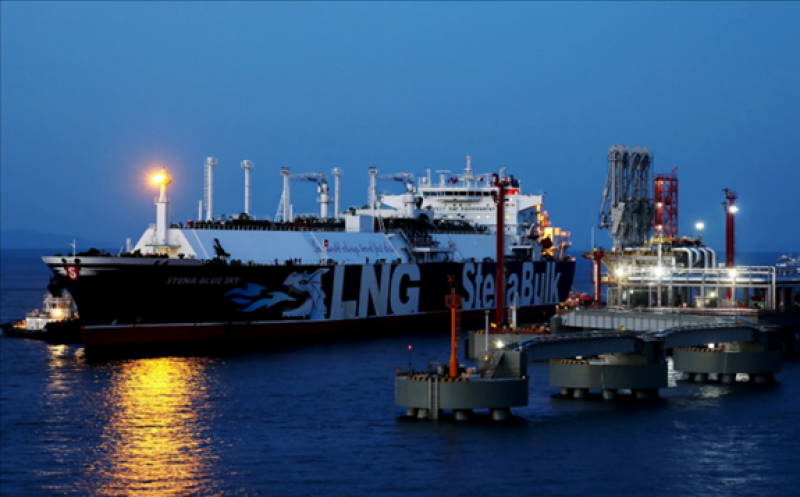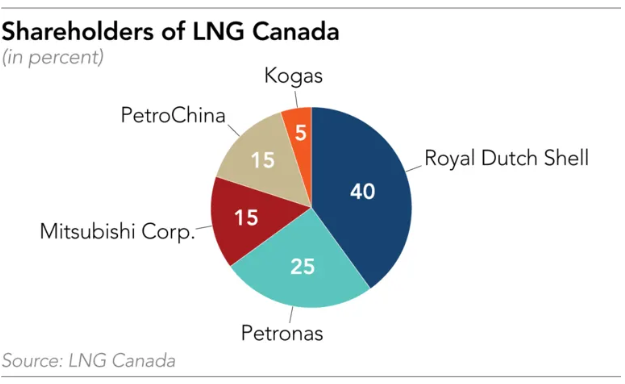 A liquefied natural gas tanker floats in port in Zhoushan, in China's Zhejiang Province: The LNG Canada project will ship fuel to PetroChina and other Asian customers. © Reuters
A liquefied natural gas tanker floats in port in Zhoushan, in China's Zhejiang Province: The LNG Canada project will ship fuel to PetroChina and other Asian customers. © Reuters
NEW YORK -- A 40 billion Canadian dollar ($30 billion) project in British Columbia led by Royal Dutch Shell is on track to start exporting liquefied natural gas to Asia as early as 2024, having received a significant financial boost from Canada's federal government.
Ottawa will provide C$275 million in subsidies to help finance the LNG Canada export project, whose partners include Malaysian state-owned oil company Petronas, Japan's Mitsubishi Corp. and two other Asian energy companies.
The federal government's move to support LNG exports to Asia comes as Canada tries to reduce its dependence on sales to the U.S. Canada is the world's fourth-biggest natural gas producer and exports half its output to its giant southern neighbor by pipeline.
The subsidies, announced in late June, are expected to be used to buy highly efficient gas turbines, which will power natural gas liquefaction plants, and to repair an aging highway bridge.
LNG Canada finalized its investment plan in October 2018. The plan calls for construction of two gas liquefaction plants, with an annual capacity of 7 million tons each, in Kitimat, British Columbia.
"The government of Canada is proud to support this historic C$40 billion project that will get our resources to new markets, diversify our trade, grow our economy and create middle-class jobs for Canadians," said Finance Minister Bill Morneau.

The LNG Canada project will bring natural gas produced in northeastern British Columbia to liquefaction plants in Kitimat via a 650 km pipeline. The five partners in the project, which also include PetroChina and Korean Gas, will receive LNG proportional to their ownership stakes. Exports to Asia will begin as early as 2024.
Natural gas liquefies when cooled to minus 162 C. LNG takes up about one-six hundredth the volume of natural gas, making it easier to transport large quantities of LNG to remote areas by tanker. Canada has had few natural gas liquefaction plants up to now because it is more efficient to transport natural gas to the huge U.S. market in its gaseous state via pipeline.
In addition to the LNG Canada project, the government has approved a number of other projects to build LNG facilities.
According to British oil company BP, Canada produced 184.7 billion cu. meters of natural gas in 2018, making it the world's fourth-biggest producer, after the U.S., Russia and Iran.
Companies such as natural gas producer Encana and energy developer Husky Energy are headquartered in Canada, which accounts for about 5% of the world's natural gas production.
Around half that output is consumed at home, with the rest exported overland to the U.S. But the U.S. will become a net exporter of energy as early as next year, due to its rising shale oil production.
Canadian natural gas exports to the U.S. sank 6% by volume in 2018 from a year earlier, and they are likely to decline faster in the future. This has forced Canada to look for new export markets in Asia and elsewhere, where demand is growing. Amarjeet Sohi, Canada's minister for natural resources, told Nikkei in an interview that Japan, China and India were promising export destinations.
With tensions rising in the Middle East, Japan hopes to reduce its heavy dependence on the region for its energy needs. Several oil tankers, including one Japanese vessel, have been attacked near the Strait of Hormuz recently. Canada will be a good energy supplier to Japan, as it is "very stable," Sohi said.
Major Japanese energy companies are also moving to expand their LNG procurement from Canada. Tokyo-based JERA has a long-term agreement with an LNG trading unit of Mitsubishi to buy up to about 1.2 million tons of LNG a year from the LNG Canada project. JERA is a 50-50 joint venture between Tokyo Electric Power Co. Holdings and Chubu Electric Power.
Tokyo Gas also has a long-term agreement with the same LNG trading arm of Mitsubishi, Singapore-based Diamond Gas International, to procure about 600,000 tons a year from LNG Canada.
The project has come under fire from Canada's Green Party, which accuses the government of subsidizing the fossil fuel industry. Environmental issues are likely to feature heavily in parliamentary elections slated for October.
Andrew Weaver, leader of the Green Party of British Columbia, said LNG cannot be the future of the provincial economy. He has denounced the federal subsidies for the LNG Canada project, saying they will not curb the country's carbon dioxide emissions.
Weaver opposes new investment in the fossil fuel industry at a time when the world is moving toward renewable energy. That position has won some support among Canadians, but the federal government sees LNG as an important part of its policy clean-energy policy.
"LNG Canada's facility will help bring a cleaner Canadian energy source to replace coal in some of the world's fastest-growing economies," said Navdeep Bains, the country's minister for innovation, science and economic development.
"The government of Canada has enabled LNG Canada's development of the lowest carbon content LNG for export in the world today," said Andy Calitz, who recently stepped down as LNG Canada's CEO.